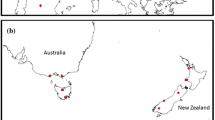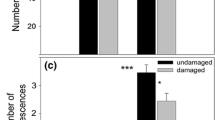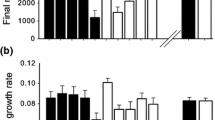Abstract
In the absence of coevolved natural enemies, plants are expected to experience selection away from costly herbivore defenses toward growth and reproduction [evolution of increased competitive ability hypothesis (EICA)], yet no one has demonstrated EICA for an indirect defense trait. Likewise, we have little understanding of how constitutive and induced levels of defense vary among native and invasive plant populations. We conducted a greenhouse experiment in the introduced range to test whether invasive populations have reduced constitutive and induced investment in an indirect defense trait, extrafloral nectar (EFN) production, compared to native populations of Chinese tallow tree, Triadica sebifera, through an experimental leaf damage treatment. Overall, native populations invested more in indirect defense: Native populations had a greater number (+16 %) and percentage of leaves producing EFN (35 vs. 28 %), produced more EFN (63 % greater volume), and produced more sugar (+33 %) compared to invasive populations, independent of damage treatment. Of these traits, number of leaves producing EFN and volume of EFN exhibited a trade-off between constitutive and induced investment but these did not depend on plant origin. Our results are the first to support the EICA hypothesis for an indirect defense trait. This suggests that tri-trophic interactions such as indirect defense are under similar selection as direct defense traits within introduced populations. Despite reduced investment in EFN production, invasive populations still retain the ability to produce EFN, which may enable invasive plants to defend against herbivores in the introduced range.



Similar content being viewed by others
References
Arimura G, Kost C, Boland W (2005) Herbivore-induced, indirect plant defences. Biochim Biophys Acta 1734:91–111
Baldwin IT (1990) Herbivory simulations in ecological research. Trends Ecol Evol 5:91–93
Beaton LL, Van Zandt PA, Esselman EJ, Knight TM (2011) Comparison of the herbivore defense and competitive ability of ancestral and modern genotypes of an invasive plant, Lespedeza cuneata. Oikos 120:1413–1419
Blossey B, Nötzold R (1995) Evolution of increased competitive ability in invasive nonindigenous plants—a hypothesis. J Ecol 83:887–889
Bossdorf O, Auge H, Lafuma L, Rogers WE, Siemann E, Prati D (2005) Phenotypic and genetic differentiation between native and introduced plant populations. Oecologia 144:1–11
Bruce KA, Cameron GN, Harcombe PA, Jubinsky G (1997) Introduction, impact on native habitats, and management of a woody invader, the Chinese tallow tree, Sapium sebiferum (L) Roxb. Nat Area J 17:255–260
Cano L, Escarre J, Vrieling K, Sans FX (2009) Palatability to a generalist herbivore, defence and growth of invasive and native Senecio species: testing the evolution of increased competitive ability hypothesis. Oecologia 159:95–106
Cipollini D, Heil M (2010) Costs and benefits of induced resistance to pathogens and herbivores in plants. CAB Rev 5:1–25
Cipollini D, Mbagwu J, Barto K, Hillstrom C, Enright S (2005) Expression of constitutive and inducible chemical defenses in native and invasive populations of Alliaria petiolata. J Chem Ecol 31:1255–1267
Cripps MG, Hinz HL, McKenney JL, Price WJ, Schwarzlander M (2009) No evidence for an ‘evolution of increased competitive ability’ for the invasive Lepidium draba. Basic Appl Ecol 10:103–112
DeWalt SJ, Siemann E, Rogers W (2011) Geographic distribution of genetic variation among native and introduced populations of Chinese tallow tree, Triadica sebifera (Euphorbiaceae). Am J Bot 98:1128–1138
Eichhorn MP, Ratliffe LC, Pollard KM (2011) Attraction of ants by an invasive Acacia. Insect Conserv Divers 4:235–238
Eigenbrode SD, Andreas JE, Cripps MG, Ding H, Biggam RC, Schwarzlaender M (2008) Induced chemical defenses in invasive plants: a case study with Cynoglossum officinale L. Biol Invasions 10:1373–1379
Franks SJ, Pratt PD, Dray FA, Simms EL (2008) No evolution of increased competitive ability or decreased allocation to defense in Melaleuca quinuenervia since release from natural enemies. Biol Invasions 10:455–466
Galen C (2005) Catching ants with honey: an experimental test of distraction and satiation as alternative modes of escape from flower-damaging ants. Oecologia 144:80–87
Herms DA, Mattson WJ (1992) The dilemma of plants—to grow or defend. Q Rev Biol 67:283–335
Herrera AM, Carruthers RI, Mills NJ (2011) No evidence for increased performance of a specialist psyllid on invasive French broom. Acta Oecol 37:79–86
Huang W, Siemann E, Wheeler GS, Zou JW, Carrillo J, Ding J (2010) Resource allocation to defence and growth are driven by different responses to generalist and specialist herbivory in an invasive plant. J Ecol 98:1157–1167
Hull-Sanders HM, Clare R, Johnson RH, Meyer GA (2007) Evaluation of the evolution of increased competitive ability (EICA) hypothesis: loss of defense against generalist but not specialist herbivores. J Chem Ecol 33:781–799
Kempel A, Schadler M, Chrobock T, Fischer M, van Kleunen M (2011) Tradeoffs associated with constitutive and induced plant resistance against herbivory. Proc Natl Acad Sci USA 108:5685–5689
Kessler A, Baldwin IT (2001) Defensive function of herbivore-induced plant volatile emissions in nature. Science 291:2141–2144
Kessler A, Heil M (2011) The multiple faces of indirect defences and their agents of natural selection. Funct Ecol 25:348–357
Koptur S (1992) Interactions between insects and plants mediated by extrafloral nectaries. In: Bernay E (ed) Insect/plants interactions, vol 4. CRC Press, Boca Raton, pp 85–132
Morris WF, Traw MB, Bergelson J (2006) On testing for a tradeoff between constitutive and induced resistance. Oikos 112:102–110
Orians CM, Ward D (2010) Evolution of plant defenses in nonindigenous environments. Annu Rev Entomol 55:439–459
Ridenour WM, Vivanco JM, Feng YL, Horiuchi J, Callaway RM (2008) No evidence for trade-offs: Centaurea plants from America are better competitors and defenders. Ecol Monogr 78:369–386
Rogers WE, Siemann E, Lankau RA (2003) Damage induced production of extrafloral nectaries in native and invasive seedlings of Chinese tallow tree (Sapium sebiferum). Am Midl Nat J 149:413–417
Rudgers JA (2004) Enemies of herbivores can shape plant traits: selection in a facultative ant–plant mutualism. Ecology 85:192–205
Siemann E, Rogers WE (2001) Genetic differences in growth of an invasive tree species. Ecol Lett 4:514–518
Siemann E, Rogers WE (2003a) Herbivory, disease, recruitment limitation, and success of alien and native tree species. Ecology 84:1489–1505
Siemann E, Rogers WE (2003b) Reduced resistance of invasive varieties of the alien tree Sapium sebiferum to a generalist herbivore. Oecologia 135:451–457
Siemann E, Rogers WE, Dewalt SJ (2006) Rapid adaptation of insect herbivores to an invasive plant. Proc R Soc Lond B 273:2763–2769
Stinchcombe JR, Rausher MD (2002) The evolution of tolerance to deer herbivory: modifications caused by the abundance of insect herbivores. Proc R Soc Lond B 269:1241–1246
Strauss SY, Irwin RE (2004) Ecological and evolutionary consequences of multispecies plant–animal interactions. Annu Rev Ecol Evol Syst 35:435–466
Tiffin P, Inouye BD (2000) Measuring tolerance to herbivory: accuracy and precision of estimates made using natural versus imposed damage. Evolution 54:1024–1029
Wang Y, Huang W, Siemann E, Zou JW, Wheeler GS, Carrillo J, Ding JQ (2011) Lower resistance and higher tolerance of invasive host plants: biocontrol agents reach high densities but exert weak control. Ecol Appl 21:729–738
Xu FF, Chen J (2009) Comparison of the differences in response to the change of the extrafloral nectar-ant-herbivore interaction system between a native and an introduced Passiflora species. Acta Bot Yun 31:543–550
Zhang KD, Lin YT (1994) Chinese Tallow. China Forestry Press, Beijing
Zou JW, Rogers WE, Siemann E (2007) Differences in morphological and physiological traits between native and invasive populations of Sapium sebiferum. Funct Ecol 21:721–730
Zou JW, Rogers WE, Siemann E (2008a) Increased competitive ability and herbivory tolerance in the invasive plant Sapium sebiferum. Biol Invasions 10:291–302
Zou JW, Siemann E, Rogers WE, DeWalt SJ (2008b) Decreased resistance and increased tolerance to native herbivores of the invasive plant Sapium sebiferum. Ecography 31:663–671
Acknowledgments
We thank C. Gabler, K. Horn, S. Siemann, M. Siemann, K. Klimas, and A. Luckey for their help in data collection and four anonymous reviewers whose comments significantly improved the manuscript. This study was supported by a U.S. NSF Graduate Research and Ford Foundation fellowship (to J. Carrillo), the 100 Talent Program of the Chinese Academy of Sciences (to J. Ding), the U.S. National Science Foundation (DEB 0820560 to E. Siemann), and the foreign visiting professorship of the Chinese Academy of Sciences (2009S1-30 to E. Siemann).
Author information
Authors and Affiliations
Corresponding author
Rights and permissions
About this article
Cite this article
Carrillo, J., Wang, Y., Ding, J. et al. Decreased indirect defense in the invasive tree, Triadica sebifera . Plant Ecol 213, 945–954 (2012). https://doi.org/10.1007/s11258-012-0055-z
Received:
Accepted:
Published:
Issue Date:
DOI: https://doi.org/10.1007/s11258-012-0055-z




